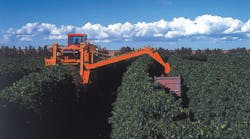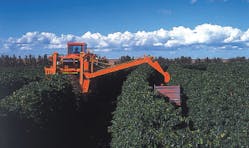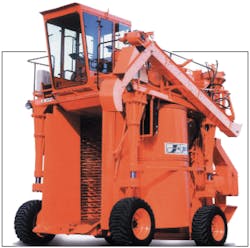Coffee production world wide is about 115 million 60-kg sacks per year. . . that's 15.8 billion lb. Of this, about 35% is attributed to Brazil — an impressive growth from 23% in the early 1990s.
Two reasons are cited for this improvement. First, the Brazilian government introduced a stabilized currency that encouraged coffee producers to export and invest in their own competitiveness. Second, agricultural machine builders developed coffee harvesters with higher productivity and energy efficiency. A case in point is Jacto SA, Pomeia, Sao Paulo, which recently introduced its KIII Advance coffee harvester. Compared to conventional harvesting methods, the KIII Advance helps reduce harvesting from 30% of total production cost to about 10%.
Productive picking process
Once at a coffee field, the KIII Advance travels at 1 to 3 km/hr (0.6 to 1.9 mph) between rows of coffee bushes. Two rotating upright members contain flexible plastic vibrating arms. Vibration of the arms can be adjusted to the particular conditions — such as bush species or coffee bean ripeness. The arms grasp and shake the branches of the bush according to machine settings.
Once loosened from the branches, the beans fall and are collected on a sieve at the bottom of the harvester. A fan blows away leaves and other light debris, and the beans are transported via pneumatic conveyor to a trailer accompanying the harvester.
After a harvester has worked an entire field, it moves onto the next. The machine can harvest up to 8500 kg (18,700 lb) of coffee beans per hour. During a 70- to 90-day harvesting season, the harvesters work virtually 24 hr/day. Consequently, time spent traveling from one field to the next cuts into productivity. For this reason, the KIII Advance's hydrostatic propulsion system can be shifted into travel mode, enabling it to reach speeds of 18 km/hr (11.2 mph). Considering the unpredictable terrain of a typical coffee plantation, this is as fast as a machine this size can safely move.
Adjustable and versatile
Conditions from one plantation to another — and from one field to another — can vary greatly. For example, coffee fields may be located on a hillside, in a valley, or on uneven terrain. Furthermore, the coffee bushes themselves usually are of different heights and may be planted with different spacing between rows.
To address these challenges, hydraulic motors drive the wheels, hydraulic actuators change the spacing (track) of the drive wheels, and additional hydraulic actuators adjust vertical spacing of the wheels — which is essential for keeping the KIII level when harvesting on a hillside.
The combination of these three features illustrates a capability of hydraulics that would be impractical by any other means. A purely mechanical solution would be bulkier, heavier, more costly, and incorporate chain and gear drives requiring intensive maintenance. Trying to accomplish the tasks electrically would be even less practical, if it could be done at all. The hydraulic solution, however, is easy to control and by far the most compact, lightweight, and reliable.
Hydraulics for propulsion
Jacto offers the KIII Advance in two-and four-wheel drive versions. Its adjustable drive operates in automatic mode for on-road operation and manual for operation in a field. The hydrostatic system is powered by an axial-piston pump, and each drive wheel is powered by a radial-piston motor with dynamic braking. Because of their design, radial-piston motors deliver low-speed, high-torque power within a small envelope.
Closed-loop control of the hydraulic system is designed to provide a consistent supply of pressurized fluid to all hydraulic actuators even when maximum torque is required of the hydrostatic drive.
The harvesters can also be equipped with electronic instrumentation to report "quantity harvested in real time" and GPS or DGPS for simultaneous monitoring of geographical position.
Information for this application was provided by Erich Nold, of Bosch Rexroth Mobile Hydraulics, Atibaia, Brazil.




